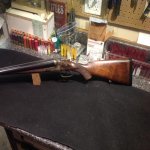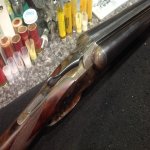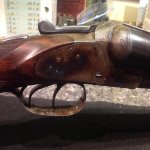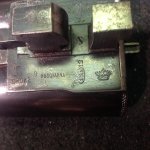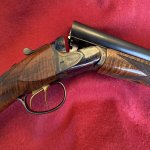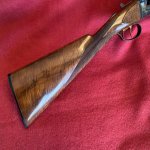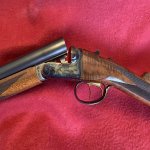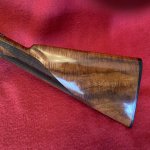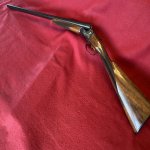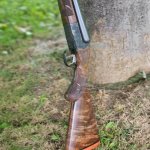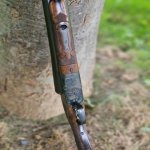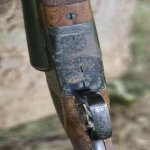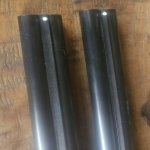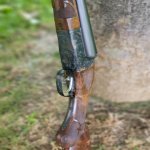All Victorian sporting guns carry with them several stories, with some more easily deciphered than others. There is usually a name on the gun, possibly the maker or at least the retailer; secondary marks and proofs that might help identify individual craftsmen or assist with narrowing a date; and perhaps proprietary features that can enrich the narrative and add to the gun's historical significance. It gets complicated when the usual clues aren't there, or are confusing.
The gunmakers were businessmen, and their businesses had their ups and downs, and not all were successful. The economics of gun-building was complex, and wealthy patrons were not always the best at paying their bills on time. Credit was the norm, though skilled workmen had to be paid – a situation frequently leading to bankruptcies. Some found ways to cut corners, a risky approach regarding safety and reputation in an otherwise rigid and highly regulated industry. On the surface, this single-barrel pin-fire gun signed "H. W. Whaley, Strood, Kent" is a fine-looking gun that has undergone period repairs and perhaps more recent restorative work. Any pin-fire single is worthy of note. These were guns ordered for a specific purpose, as their cost was not far different from the more usual double-barrelled configuration. They were not the entry-level or beginner guns that most single-shots are today. The dimensions are for a person of typical stature, and the level of decoration is in keeping with a quality gun of provincial make (Strood is a small town about 40km east of London). The action is the design of Robert Adams of London (the inventor of the Adams revolver), and the inert under-lever mechanism shown here is his patent No. 285 of 1860. In a letter to the weekly sporting paper
The Field dated 6 February 1864, Adams stated his guns were
"my own patent, made on my own premises, and under my own supervision," when challenged about the origins of his pieces, clearly establishing his 76 King William-street workshop as the sole builder and purveyor of his patent action.
I expected to find an Adams patent mark or at the least a patent-use number on the action, should Adams have licensed others to make or use his action, so I was surprised to find no markings of any kind, not even provisional proofs. The story got darker, finding no proof marks on the barrel, only a bore stamp (15). The 28 1/16-inch barrel is of twist construction and is partially half-16-sided to half-8-sided towards the breech, suggesting it was repurposed from a muzzle-loader; the chamber is bored for the 14-gauge pin-fire cartridge. Whatever marks might have been on the original barrel were gone, and once rebuilt, it was never submitted for proof to the London or Birmingham Proof House, a grave offence under the Gun Barrel Proof Act of 1855. Adams was not unaware of the risks of avoiding the proof house: in February of 1860, he was fined £10 for having sold a rifle whose barrel lacked proofs, claiming in court he had sent it out
"by mistake." He subsequently had to recall twenty rifles, to avoid paying additional fines of £20 for each one. One can assume he did not want further risk to his finances and reputation.
Had Mr. Adams not made the action, could the provincial gun maker have made it? With no way to date the gun, it possibly was made after the Adams patent lapsed. However, there would have been far easier and more robust designs to copy by such time than the Adams. Other than the barrel, the gun shows no sign of being any sort of conversion. The Adams action was popular in the early 1860s until it was largely displaced by the Henry Jones double-bite screw-grip, which could be built royalty-free after that patent expired at the end of 1862. Adams's guns under this patent were of the bar-in-wood type, hiding a narrow action bar and the hinge beneath the woodwork. Making any bar-in-wood gun is not for the faint of heart – the fit of metal and wood has to be perfect, and this is the only bar-in-wood single-barrel pin-fire gun I've ever come across, in hand or in print. Once again, it's not an entry-level knockabout gun. The lock is called an "island lock," surrounded by wood, a pattern used to great renown by James Purdey. Very little metalwork is apparent, giving it the look of a fine muzzle-loading gun.
The name and address on the gun, Henry Watson Whaley of Strood, Kent, offers another avenue to the investigation. He was born in Lynn, Norfolk, around 1805. His father, John, was born in 1781 and was a gunmaker by trade, and Henry likely apprenticed under him. John Whaley & Son traded in High Street, Strood, starting in 1831. Henry married in 1834, but happiness was replaced with trouble in the business. In June 1839, the company was dissolved, with both the father and son being sued and ending up in the notorious Marshalsea debtors prison that year. Around 1844, Henry resumed the business under his name at 46 High Street. There must have been a severe falling-out between Henry and his father, as on 13 November 1849, he took out an advertisement in the
South Eastern Gazette announcing
"that John Whaley, Sen., his father, has left him, and has no connection whatsoever with his business, and that the said John Whaley, Sen., is not authorized to receive any money or take orders on account of Henry Watson Whaley, from this date." Nothing much else is known about the business. Henry died in 1881, and the business was continued by Edward Palmer until around 1894.
Unfortunately, there is no way of knowing if Robert Adams's workshop made the action, or if it was made under licence (or not) by Henry Watson Whaley at the High Street address. From the possibly repurposed barrel, I presume it was fitted and the gun assembled by Whaley; the special-order nature of the gun might help explain why the action and barrel were never proofed, being a one-off order, perhaps made under time pressure. In any case, it is fine work and aesthetically pleasing for what was legally a counterfeit gun! 14 gauge was popular then, and the single barrel and bar-in-wood construction made for a light gun at 5 pounds 10 ounces. The silver shield stock escutcheon is unmarked, leaving no clue as to the original owner; the gun is unnumbered, which is not unusual for a gunmaker producing a minimal number of guns in a year, and in any case, no Whaley records have survived. The period repair, an inletted pinned metal strap straddling the hand and comb, shows that someone wanted to keep the gun in the field despite a broken stock, perhaps sometime after the pin-fire system was out of fashion. Two other repairs, filler added around the lock and a possibly replaced fore-end tip of darkly-stained wood instead of horn, suggest later amateur repairs or restoration work of a lower quality, perhaps when the gun was relegated to wall-hanger status. Despite these minor blemishes, the gun is interesting, unusual, and storied. The stock is nicely figured, and the flat-top chequering is well executed. Exactly who made the gun cannot be determined; so is the reason for its construction or why it escaped the proof house. Few Whaley-marked arms of any type (by father or son) have surfaced, so it is impossible to know if it was typical in build or quality. Perhaps something will turn up that will help fill out the story.




















































